#1 delt with guns. #2 deals with climate change and why that is so hard on younger people.
If you are over 50, you will probably be dead before your world is severely damaged. Towards your end you will have regrets, but you won’t suffer long. If you’re 30 to 50 you’ll see what is happening, but unless you are a politician, will have little opportunity to change the future. If you are under 30 there is time to affect your future, but politicians who lack the ability to imagine 10 or even 5 years from now, control your world.
Researchers with the U.K.’s University of Bath and other schools spoke to 10,000 people in 10 countries, all of whom were between the ages of 16 and 25, to gauge how they feel about climate change. The prevailing response could be summed up in two words: incredibly worried. And the respondents say governments aren’t doing enough to combat climate change.
Across all the countries represented — the United States, the United Kingdom, Australia, Brazil, France, Finland, India, Nigeria, Portugal and the Philippines — 65% of young people felt their government was failing them on climate change and 60% felt that the government had been dismissing citizens’ distress over it. Nearly half of those who said they talk with other people about climate change said that their concerns were ignored, according to researchers.

Here are charts of carbon dioxide levels.
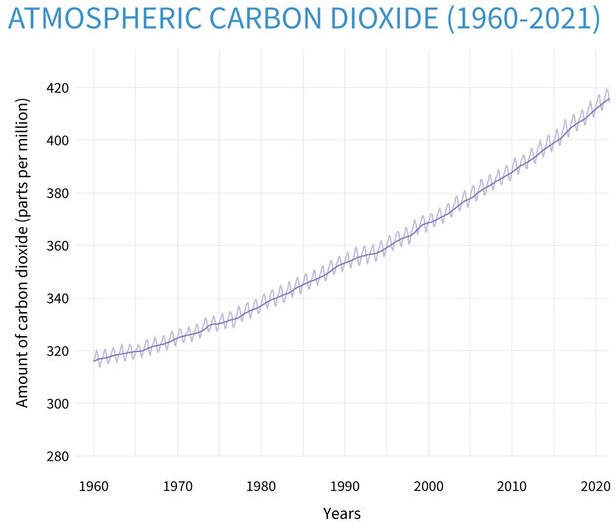
Hundreds of years data from ice core samples.
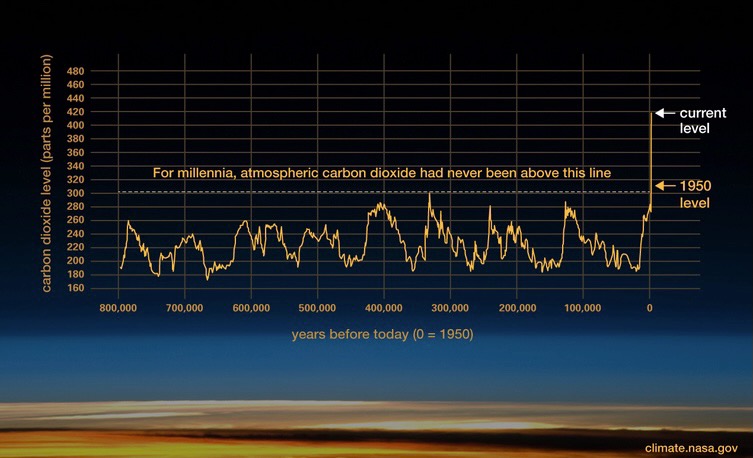
Rather then repeating the usual warning about wild fires caused by drought, greater power of hurricanes, enormous rainstorms overwhelming our sewer systems and rising sea levels that will flood many coastal areas during mild storms, let’s clear up some questions then get to the scarily stuff.
Global warming is not all bad. For example, Canada and Russia will be able to grow more grain as their northern territories get warmer. Tropical diseases that cannot survive cold weather will be able to thrive as the southern US avoids frosts.
How can there be warming when recently we are experiencing really cold waves? Hot air rises, flows north and lays on top of cold arctic air which is pushed down south for our enjoyment. So now warm air covers the arctic. This is why the arctic is warming faster than the rest of the earth. Also with less ice to reflect sunlight, the land and sea get warmer.
What are US forces doing about climate change and why? You are footing the bills.
The aftermath of Hurricane Florence dumping 36 inches of rain on North Carolina in 2018 saw three Marine Corps installations flooded, costing taxpayers $3.6 billion in damage. A few weeks later, Hurricane Michael ripped through Tyndall Air Force Base, causing about $4.7 billion in damage at the Florida facility. Then last year, leaders evacuated Travis Air Force Base in northern California due to nearby raging wildfires. Defense Secretary Lloyd Austin, identified climate change as a top priority.
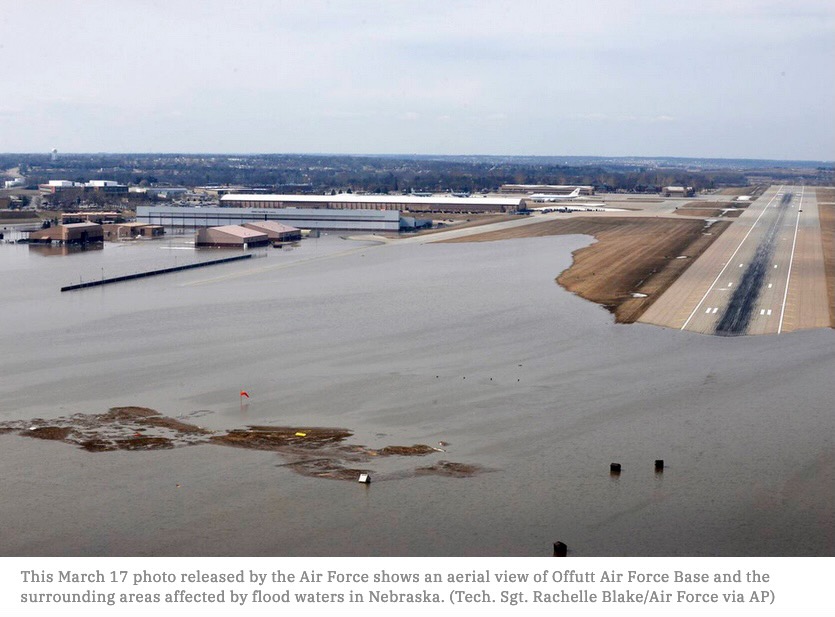
In a 2019 report to Congress, the Army listed desert making as the top climate threat to nine of its top 10 most vulnerable stateside bases. Sea level rise particularly threatens naval bases. The Hampton Roads, Virginia, area, home to the largest concentration of military infrastructure in the world, is already under threat of flooding, with the sea level near the area expected to rise 1.5 feet in the next 20-50 years.
The Atlantic Ocean flow pattern described below.
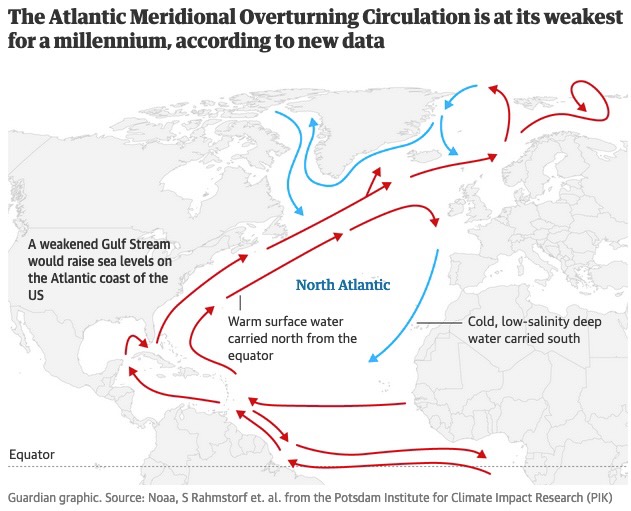
Europe is kept much warmer than would be without this current that takes heat from the warm Caribbean and carries it up towards Europe. Then as Greenland’s glaciers melt, the colder water flows south closing the current’s loop.
Now let’s get to two lesser known, but much more frightening climate threats.
#1 The thawing of permafrost.

Permafrost is created when the surface temperature stays so cold that deep underground land remains frozen and biological activity stops indefinitely. Climate change is keeping surfaces warmer which penetrates the land thawing permafrost so that solid soils turn into mud. Mud cannot support structures and hills, leading to mud slides. Might be fun for kids, not old folks.
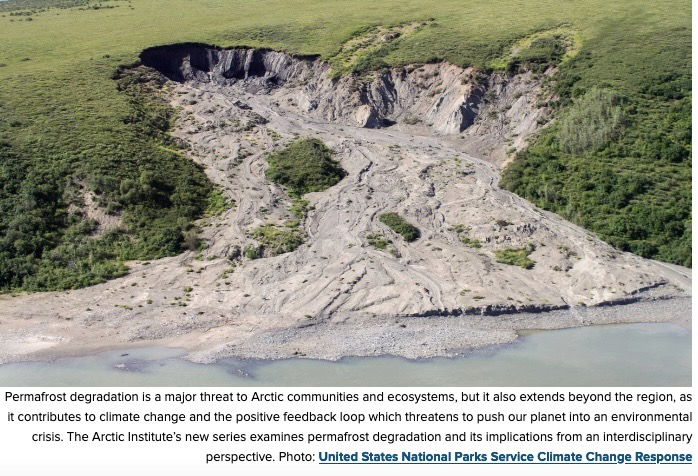
Bacteria love mud then they can decompose all the dead leaves, grasses and animals that have been buried for thousands of years. Decomposing releases carbon dioxide and methane which lead to a more heat trapping atmosphere, which causes more thawing that releases more gases. This process is a feedback loop that is way beyond our control so even if we stop making warming gases, nature continues to make them for us.
#2 Thawing of methane clathrates.
The release of methane gas from the artic lakes and permafrost and deep oceans.
Methane clathrates are common constituents of the shallow marine geosphere and they occur in deep sedimentary structures and form outcrops on the ocean floor.
Methane Clathrate (Methane Hydrate) refers to methane gas that’s trapped – by temperature and pressure – in a molecular “cage” of frozen water molecules. When the water warms the frozen-water clathrate “cages” dissolve and methane gas is released. Methane gas is over 80 times more effective in trapping heat than carbon dioxide, thus is much more dangerous.
This is another natural feedback loop beyond our control. Enjoy the video!
